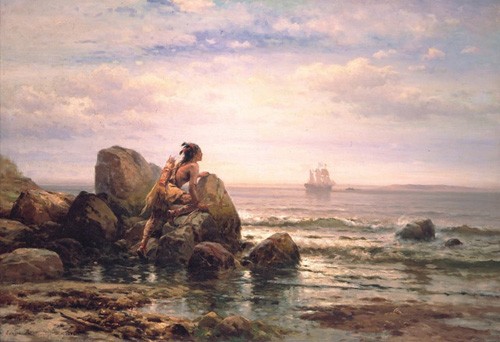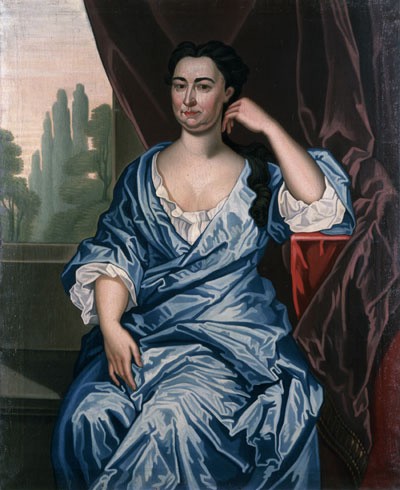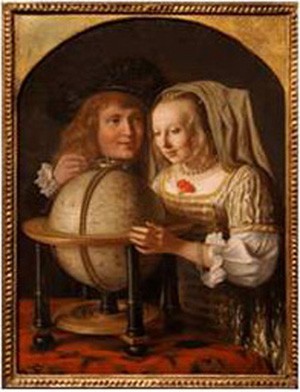Dutch New York
New York's History Re-Visited Through Art
By: Adam Zucker - Sep 09, 2009
June 13, 2009 - January 10, 2010Hudson River Museum
511 Warburton Avenue
Yonkers, NY 10701
914.963.4550
Dutch New York: The Roots of Hudson Valley Culture at the Hudson River Museum creates a historical narrative of the Hudson Valley's earliest Western European settlers through a visual display of fine art, illustration, and primary historical documents. The exhibition marks the 400th anniversary of Henrik Hudson's 1609 voyage into the "New World" for the Dutch East India Company.
The exhibition begins with the compelling and often romanticized image of Hudson's ship, the Half Moon. Edward Moran's, Henrik Hudson Entering New York Harbor (1892), portrays Hudson's first contact with the Native Americans. This painting is an aesthetically imagined scene, sublimely suggesting that an enormous transformation will soon alter the history of this land forever. This was the beginning of the short but monumental Dutch colonization of the Hudson Valley River. From Hudson's arrival until the British takeover in 1664, Dutch entrepreneurs developed the extensive and profitable trade of goods and ideas in what became known as New Netherlands. On display are many illustrations, maps, documents, and goods that the Dutch capitalists brought over to their new settlement across the Atlantic.
The 17th century certainly was a period of enlightenment for the Dutch explorers who longed to develop their expansionist ambitions. We begin to see some glaring parallels between New Netherlands and modern North America, specifically within the modern day Hudson River Valley. Common threads include the desire to expand influence beyond local borders, the booming capitalist trade market, religious tolerance, architecture, city planning and folklore.
Long after the Dutch relinquished their control to British rule, their heritage could be seen and felt in the colonist's language, dress, religion and building construction. Structures such as the Dutch Reformed Church and traditional Dutch farmhouses with windmills were commonplace. The exhibition displays a wonderful array of objects and furnishings that traditionally would have been seen inside a Dutch estate in New Netherlands. Portraits of wealthy as well as middle class Dutch families show the elaborate style and beauty that was characteristic of their social-cultural importance.
Mainstream culture would soon have a fall out with the Dutch ideology. The 18th and 19th centuries began to portray Dutch colonists in a very burlesque manner. The exhibition features the work of American painter John Quidor, who created aesthetic renderings from Washington Irving's writing. This includes visual compositions of Irving's Legend of Sleepy Hollow, and Rip Van Winkle. Irving's portrayal of Stuyvesant described the Dutch patriot to be (among other negative characterizations) "mettlesome, and obstinate." Quidor's painting Antony Van Corlear Brought Into the Presence of Peter Stuyvesant," (1839) depicts an unflattering pudgy peg-legged tenacious Stuyvesant, in his office smoking from a pipe, while using his walking stick to conduct the music of his trumpeter Van Corlear. The artist also includes two wildly moving old men, one white and one black, in the background.
Despite such negative attention and degradation, the importance of the Dutch colonization has withstood the test of time. One hundred years ago, near the 300th anniversary of New York's colonial past, the Hudson-Fulton celebration united New Yorkers of all backgrounds. Diverse New Yorkers welcomed the rediscovery of New York's history and saw the influence that the Dutch colonialists still have on our culture today. There couldn't be a more fitting commemoration of a 400-year anniversary than the retrospective at the Hudson River Museum, situated along the river that Henrik Hudson navigated in the summer of 1609. Thanks to the Hudson River Museum and curators Bart F. Bland and Laura L. Vookles along with Roger Panetta, our generation can reflect upon and recognize the history of the land we have made our home.





